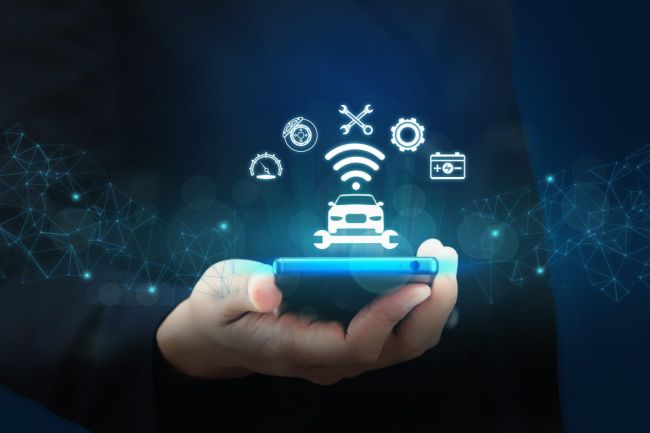
How Will AI Impact Your Fleet Operations?
 Artificial intelligence is reshaping fleet management – whether you notice it or not – to improve operations, enhance safety and reduce costs.
Artificial intelligence is reshaping fleet management – whether you notice it or not – to improve operations, enhance safety and reduce costs.
But if you’re not consistently following all the latest developments in AI, it’s easy to feel overwhelmed and left behind.
So, what’s the current state of AI in fleet? What capabilities can we expect to see in the future? How will it impact you and your team?
Mike Stallone, vice president of software engineering at Holman (www.holman.com), a global fleet management company, shares these seven points to consider.
1. You’re already using AI.
Stallone said that AI has become so integrated into telematics, fleet management software and everyday applications – like Microsoft Office 365 – that many fleets are using it without recognizing it as AI.
Route optimization software, for example, often uses AI algorithms to determine the most efficient paths based on multiple variables such as traffic, distance and delivery windows. Telematics systems employ AI to process and interpret vast amounts of real-time vehicle data. Driver safety programs use AI to analyze driving patterns and identify risky behaviors.
“There are a tremendous number of places where AI is helping fleet managers know things that they would not have known 10 or 20 years ago,” Stallone said.
2. AI can define the optimal preventive maintenance schedules.
By aggregating data from various sources – including vehicle telematics, maintenance records and operational data – AI can determine the most cost-effective preventive maintenance schedules for different vehicle types and applications instead of simply following the manufacturer’s generalized schedule, Stallone said. This level of granularity allows fleet managers to tailor their maintenance strategies to individual vehicles and specific use cases within their fleet to achieve the lowest possible maintenance costs.
3. Combining sensor data with AI can predict equipment failures before they happen.
“We’ve seen this more on the rail side,” Stallone said. “They’ve put sensors on certain parts of their equipment and noticed that, with all that data that they’re receiving, that with heat and a certain number of vibration points, they can tell when certain parts of their equipment will fail. This predictive capability allows for incredibly precise maintenance scheduling, often catching potential issues before they lead to breakdowns.”
While this example is from rail operations, Stallone said it illustrates the potential for similar applications across various types of fleet equipment and vehicles. As sensor technology becomes more advanced and affordable, this type of predictive maintenance could become more common across many fleet operations, significantly reducing unexpected downtime and repair costs.
4. AI provides comprehensive driver scoring and identifies high-risk drivers.
Stallone describes how AI is transforming driver management by creating more comprehensive and nuanced driver scoring systems. By integrating data from multiple sources – including telematics data (which can capture driving behaviors like speeding, harsh braking and acceleration) and motor vehicle records – AI can create a holistic picture of driver performance.
This approach identifies high-risk drivers with greater accuracy than traditional methods. It can also pinpoint specific areas where a driver may need improvement, allowing for more targeted training and intervention strategies. The goal, as Stallone pointed out, is not just to identify problematic drivers but to “move them more to the center” to improve overall fleet safety and efficiency.
5. Proceed with caution with large-scale implementation.
“We’re testing these technologies extensively internally before introducing them to our customers because there’s an inherent risk with exposing generative AI models to our customers, especially with the potential of ‘hallucinations,’” Stallone said.
He cited an example of an airline chatbot that provided incorrect refund information, leading to substantial legal complications. In a fleet management context, this could lead to issues if, for example, an AI system gave incorrect maintenance advice or misinterpreted company policies.
Stallone underscored the need for careful implementation of AI systems, especially in customer-facing roles. He said that, at least in the near term, AI is best used to augment human decision-making rather than replace it, particularly in areas where errors could have significant financial or legal consequences.
6. Future AI applications will make decisions and take action.
Stallone anticipates a shift toward AI systems that can act autonomously based on their analyses.
“Right now, the large language models are really good at providing textual information. We’re using it as a coach to help upscale our people,” Stallone said. “But the future for us is to use these language models to also help us take action – not just telling you what to do but also helping you do it.”
For example, rather than simply alerting a fleet manager that a vehicle is due for maintenance, an AI system could automatically schedule the maintenance appointment, considering factors like vehicle availability, shop capacity and operational needs.
7. AI will augment staff, not replace them.
Instead of viewing AI as a replacement for human workers in fleet, Stallone sees it as a tool to enhance their capabilities. For example, an AI system could provide a maintenance technician instant access to vehicle history, diagnostic information and repair guidelines, allowing them to complete repairs more efficiently and accurately. This perspective on AI is crucial for fleet managers to understand, as it frames AI as a collaborative tool rather than a competitive threat, potentially easing adoption and encouraging staff to embrace these new technologies.
The Bottom Line
By understanding AI’s capabilities and limitations, you’ll put yourself in the best position to turn potential disruptions into opportunities for growth, efficiency and innovation. After all, the question isn’t whether to adopt AI but how to do so in a way that best serves you, your team, and your internal and external customers.

